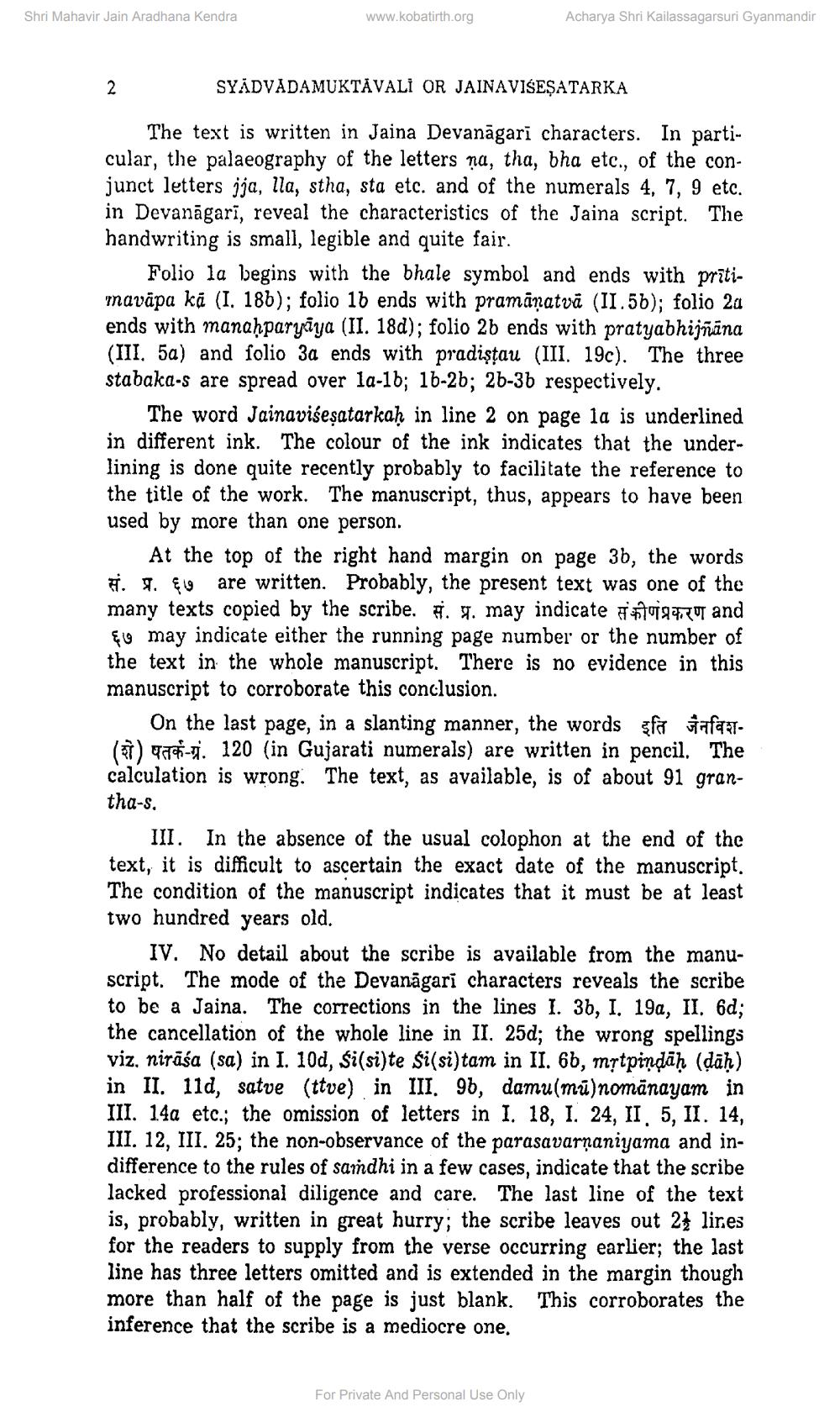________________
Shri Mahavir Jain Aradhana Kendra
www.kobatirth.org
Acharya Shri Kailassagarsuri Gyanmandir
2
SYÄDVADAMUKTĀVALI OR JAINAVIŠESATARKA
The text is written in Jaina Devanāgarī characters. In particular, the palaeography of the letters na, tha, bha etc., of the conjunct letters jja, lla, stha, sta etc. and of the numerals 4, 7, 9 etc. in Devanāgarī, reveal the characteristics of the Jaina script. The handwriting is small, legible and quite fair.
Folio la begins with the bhale symbol and ends with pritimavāpa kā (I. 186); folio 1b ends with pramāṇatvā (II.5b); folio 2a ends with manahparyiya (II. 18d); folio 2b ends with pratyabhijñāna (III. 5a) and folio 3a ends with pradiştau (III. 19c). The three stabaka-s are spread over la-1b; 16-2b; 26-3b respectively.
The word Jainaviseşatarkaḥ in line 2 on page la is underlined in different ink. The colour of the ink indicates that the underlining is done quite recently probably to facilitate the reference to the title of the work. The manuscript, thus, appears to have been used by more than one person.
At the top of the right hand margin on page 3b, the words T. 9. Ele are written. Probably, the present text was one of the many texts copied by the scribe. 8. 9. may indicate 199RO and gu may indicate either the running page number or the number of the text in the whole manuscript. There is no evidence in this manuscript to corroborate this conclusion
On the last page, in a slanting manner, the words fa fafazi() 07 . 120 (in Gujarati numerals) are written in pencil. The calculation is wrong. The text, as available, is of about 91 grantha-s.
III. In the absence of the usual colophon at the end of the text, it is difficult to ascertain the exact date of the manuscript. The condition of the manuscript indicates that it must be at least two hundred years old.
IV. No detail about the scribe is available from the manuscript. The mode of the Devanāgari characters reveals the scribe to be a Jaina. The corrections in the lines I. 36, I. 19a, II. 6d; the cancellation of the whole line in II. 25d; the wrong spellings viz, nirāśa (sa) in I. 10d, $i(si)te $i(si)tam in II. 6b, mytpindāḥ (dāḥ) in II. 11d, satve (ttve) in III. 96, damu(mū)nomānayam in III. 14a etc.; the omission of letters in I. 18, I. 24, II, 5, II. 14, III. 12, III. 25; the non-observance of the parasavarşaniyama and indifference to the rules of samdhi in a few cases, indicate that the scribe lacked professional diligence and care. The last line of the text is, probably, written in great hurry; the scribe leaves out 21 lires for the readers to supply from the verse occurring earlier; the last line has three letters omitted and is extended in the margin though more than half of the page is just blank. This corroborates the inference that the scribe is a mediocre one.
For Private And Personal Use Only




